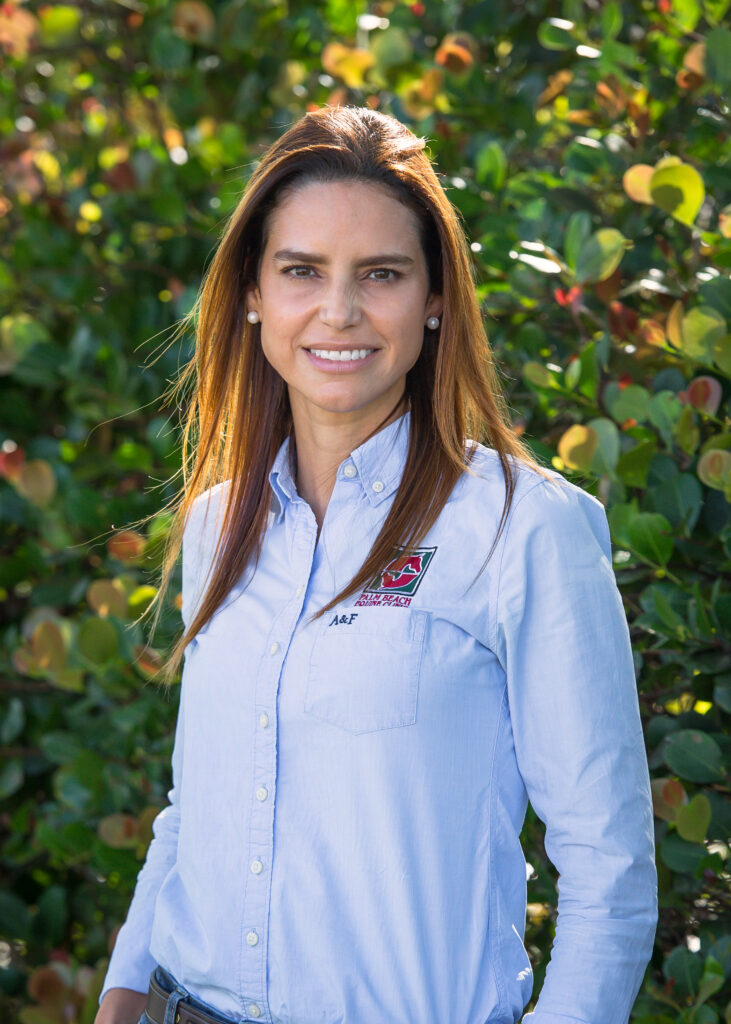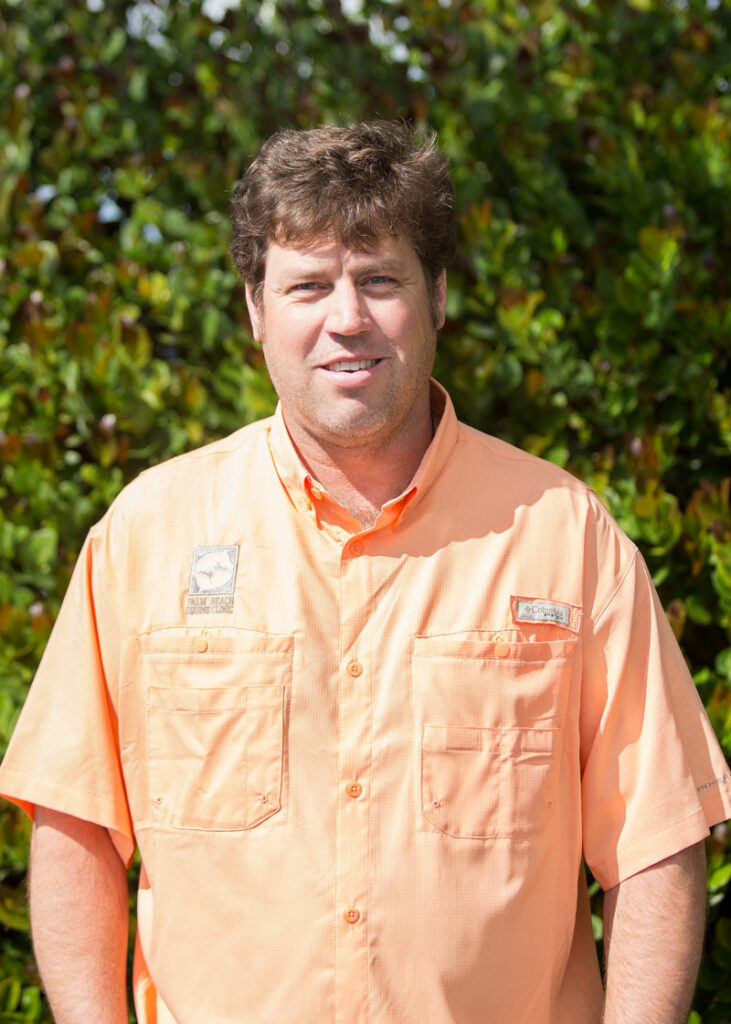Tag: horse health
Healthcare Reminder: Equine Summer Sores
The summer weather is here! With the humid weather, pesky flies are at their worst, which creates problems for many horse owners often leading to summer sores, medically known as Habronemiasis.
What are Summer Sores?
Summer sores are lesions on the skin caused by the larvae of equine stomach worms Habronema. These worms in the horse’s stomach produce eggs that pass through the digestive tract and are shed in the horse’s feces. Barn flies typically gather around manure and ultimately collect the parasite’s larvae on their extremities. Summer sores will occur when flies carrying the larvae deposit the eggs onto an open wound or the mucous membranes of a horse. The larvae infect the open wound or mucous membranes, causing an inflammatory reaction including symptoms of inflammation, discharge, and the production of granulation tissue infected with larvae.
Detecting Summer Sores
One way to detect a summer sore is the visible granulation of tissue containing small yellow, rice-like larvae within the skin and a mucopurulent (mucus or pus-like) discharge associated with the wound. Prevention is the most effective way of controlling summer sore outbreaks and the best way to protect horses is to implement effective methods for:

- fly control
- manure removal
- proper wound care
- an effective de-worming program
A diligent de-worming program is the most important element of prevention because effective de-wormer disrupts the parasite’s life cycle internally. The key is to kill both adult worms in the stomach and the larvae that form in the skin tissue.
Treating Summer Sores
For treatment of summer sores themselves, corticosteroids are administered to reduce the inflammatory hypersensitivity reaction, and antimicrobials treat any secondary infections that may develop as the result of an open wound. If not treated properly, summer sores can last up to several months and possibly require a costly surgical procedure to remove the granulated tissue and larvae. At the first sign of a summer sore, contact your veterinarian at Palm Beach Equine Clinic at 561-793-1599 to discuss treatment and develop an effective fly-management program for your barn.
As the summer heat rapidly approaches, the veterinarians of Palm Beach Equine Clinic remind all equine owners to keep their horses well hydrated.
Fresh, Clean Water
The average horse drinks between five and 10 gallons of water per day. It is important to provide clean, fresh water at all times and be aware of possible increased water consumption during extremely hot days.
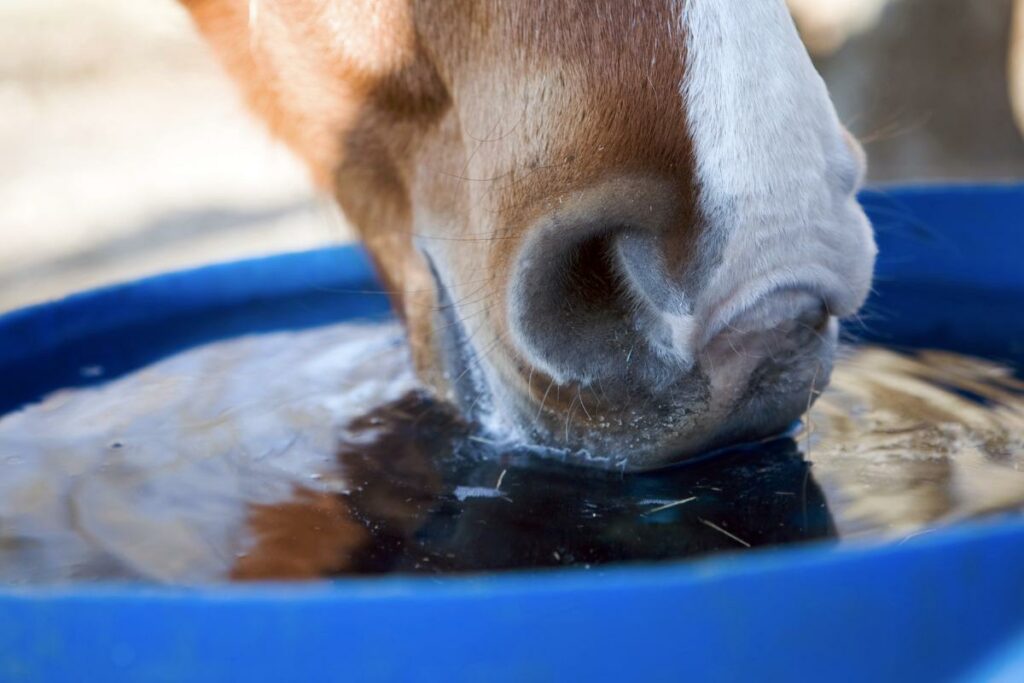
Salt
Sodium in a horse’s diet is also very important to maintain proper hydration. Providing a salt block or supplementing with electrolytes can help ensure that a horse is meeting their sodium requirements.
Sweat It Out
Especially in the extreme summer heat, horse owners should pay attention to the amount of sweat their horse is producing. Anhidrosis, or the inability to sweat normally, can be a common challenge during the summer months, particularly in hot, humid climates. A horse with Anhidrosis is often called a “non-sweater.” In addition to lack of sweat, signs of Anhidrosis can include increased respiratory rate, elevated temperature, areas of hair loss, and dry, flaky skin. Presentation of these signs indicates that the horse should be seen by a veterinarian immediately.
Additional Tips
Make sure your horse has…
- Access to shade throughout the day.
- Exercise that is scheduled when the temperatures are lower, usually earlier or later in the day.
- Turnout that is limited to the night or cooler portions of the day.
- Fans indoors during extreme heat.
- Electrolyte supplementation as needed per veterinarian’s recommendation.
Chinese herbal medicine is a relatively new treatment among equine veterinarians in the western world, but the philosophy of herbals for healing has existed for thousands of years as part of Traditional Chinese Veterinary Medicine (TCVM). Helping to lead the Chinese herbal medicine charge westward, veterinarians at Palm Beach Equine Clinic (PBEC) have incorporated the use of herbs and herbal treatments as an integral part of their alternative therapy options for patients.
Similar to the use of all-natural methods to treat illness in humans, herbal medicine for animals also utilizes ancient Chinese formulas aimed at treating the underlying causes of a disease or illness to help the body heal itself, rather than only temporarily treating the presented symptoms.
One PBEC veterinarian who has found these all-natural methods as a benefit in her treatments is Dr. Janet Greenfield-Davis, who specializes in both acupuncture and Chinese herbal medicine.
“There is an herbal product for anything,” said Dr. Greenfield-Davis, who found herbal medicine six years ago when she started specializing in acupuncture, which joins Chinese herbal medicine as two of the most common forms of TCVM therapies. “Herbals treat a variety of ailments from sore muscles to problems affecting the liver, heart, kidneys, joints, and more. I pair the herbals with my acupuncture, which is traditionally the ancient Chinese way.”
Traditional Chinese Veterinary Medicine (TCVM) Methods

In TCVM, once a symptom of disharmony in the body or disease is identified, treatment proceeds through four possible branches, including acupuncture, food therapy, a form of Chinese medical massage called Tui-na, and Chinese herbal medicine. From topical treatments, including salves and powders, to edible treatments, Chinese herbal medicine not only draws on natural products, but also on the natural tendencies of the horse itself. Being herbivores, horses ingest herbs found in the wild while they are grazing.
While the traditional methods date back thousands of years, the treatments developed within Chinese herbal medicine are ever-evolving. Coupled with modern technology, historical and ancient Chinese wisdoms are still very effective. In addition, the treatments utilize the properties of many common herbs with widely known uses. By utilizing ginseng for fatigue, chamomile for calming, garlic as an antibiotic, and arnica as an anti-inflammatory, the recipes used in herbal medicine draw from only natural sources. This is making herbal treatments more common among sport horses that undergo drug testing for banned substances while competing.
“The competitive world is accepting herbal medicine more and more every year,” said Dr. Greenfield-Davis. “It provides an alternative for horses at high levels, especially in FEI classes, that need a little extra support. They aren’t drugs, they don’t test, and they are a natural product.”
Alternative Options
Dr. Greenfield-Davis believes that offering such alternative treatment options is a sizeable advancement for PBEC, in that herbal medicines provide owners with another option when traditional western medicines may not be their preference.
“It enhances our practice because it gives owners a place to turn,” she said. “There is a lot of stigma to using particular western drugs, and I think this gives people a choice; they don’t have to use the traditional western medicines anymore because they can now turn to eastern medicines.”
While it is a personal choice to use a more holistic or all-natural approach to veterinary care for some horse owners, herbs also represent a practical alternative. According to Dr. Greenfield-Davis, herbal medicine is the perfect choice when treating a horse with an aversion to needles, or for horses that do not respond to particular medicines or therapies.
“We are able to work in a more natural way instead of using steroids and things of that nature,” added Dr. Greenfield-Davis. “In some cases, I will use solely herbals and the treatments produce a lot of wonderful results.”
As PBEC continues to advance its alternative medicine therapies, the equestrian community is also learning to accept new possibilities. For PBEC and Dr. Greenfield-Davis, Chinese herbal medicine is a step into the future with a nod to ancient Chinese history.
About Dr. Janet Greenfield-Davis
Dr. Greenfield-Davis grew up in Northern California, and her passion for horses started during her time showing hunters on the “A” circuit, which later led her to study veterinary medicine at California Polytechnic State University. She graduated from veterinary school at the University of Glasgow in 2010 and has since specialized in equine acupuncture and herbal medicine. Dr. Greenfield-Davis hopes to continue her studies in holistic medicine by incorporating food therapy into her treatments at Palm Beach Equine Clinic.
Palm Beach Equine Clinic combines the best of conventional and alternative medicine to provide comprehensive, full-body care to both sport and companion horses. Dr. Natalia Novoa specializes in utilizing the best of both approaches to provide unmatched results.
“I believe that treating issues with both alternative therapies and conventional medicine is a perfect approach,” said Dr. Novoa, who has been a full-time member of Palm Beach Equine Clinic since 2011. “We can’t exchange one for other, and the combination usually makes for a great treatment plan.
“A chiropractic adjustment is an alternative therapy that I absolutely recommend,” continued Dr. Novoa. “It’s very useful for a horse that has injuries or soreness issues, but it’s also something that is very important for maintenance. You want to prevent problems instead of treat them. If a misalignment happens, that creates incorrect friction, which then leads to pain in the joints, muscle soreness, and stress on the tendons and ligaments, possibly leading to a soft tissue injury. Another advantage of chiropractic adjustments is that it is useful for FEI competition horses because of the restriction on medications at that level. It’s a way we can effectively treat a problem and stay within the regulations.”
According to Dr. Novoa, veterinarians who incorporate chiropractic adjustments in their treatment options do so with their own style. She has developed a system that she finds most effective, and her secret is out!
Dr. Novoa’s five steps to a chiropractic adjustment:
1. Horse History
Patient history is a pillar of medicine, which provides pivotal information.
“I always want to speak with riders, trainers, and grooms to get an understanding of what they feel and see,” said Dr. Novoa. “They spend the most time with the horse and know it the best. Sometimes, clients ask me to evaluate the horse first and tell them what I see and feel, which is when most people ask me if I have a crystal ball.”
While Dr. Novoa doesn’t travel with a crystal ball, her skill at reading a horse leads her to the second step.
2. Scan Acupuncture Points – “Acuscan”
A scan of the acupuncture points on a horse, which Dr. Novoa calls an “acuscan,” is always her next move. She checks the main acupuncture points from head to tail by using her tool of choice – the round end of a needle cap. This allows her to put firm pressure on a very specific point and then evaluate the horse’s reaction to that pressure.
“A reaction can indicate, for example, left front lameness or a sore neck, etc.,” said Dr. Novoa. “It’s not voodoo; you are piecing together your findings in the exams with the symptoms that the horse is presenting.”
3. Evaluate Horse Movement
After scanning the horse, Dr. Novoa likes to always see the horse move to dig deeper into any reactions she noticed while checking acupuncture points. She starts at the walk and then observes at the trot.
“This is where I incorporate conventional medicine and supplement my evaluation with flexion tests or hoof testers depending on what I see,” said Dr. Novoa. “I want to produce the most detailed picture before moving on to the adjustment.”
4. Make the Adjustments
“I adjust a horse the same way every time,” said Dr. Novoa. “This specific order ensures that I don’t miss anything and the horse receives a thorough adjustment of its entire body with special attention paid to any problem areas that I uncovered earlier in the process.”
Check and adjust these 10 points:
Point 1: TMJ (temporomandibular joint)
Point 2: Poll and neck
See fig. 1 & 2
Point 3: Front limbs, including lower limb joints and carpus (knee)
See fig. 3
Point 4: Shoulder and scapula on both sides to compare one with the other
Point 5: Withers
Point 6: Pelvis and back
See fig. 4


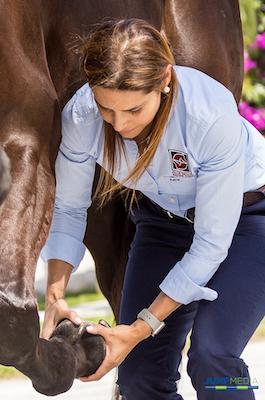

Point 7: Hind limbs, including hocks and stifles
Point 8: Sternum and T1/T2 vertebrae
Point 9: Tongue release
Point 10: Myofascial release if muscles spasm or a tense back and neck are indicated
5. Secondary Acupuncture Point Scan
“The final piece of the puzzle is to scan the acupuncture points again to compare what we had before versus what we have after the adjustment,” said Dr. Novoa. “If there are still reactions, I may do acupuncture or electro-acupuncture and utilize a class four regenerative laser.”
After her secondary scan, Dr. Novoa formulates a short and long-term treatment plan. In her experience, adjustments last for four to six weeks before a follow-up adjustment is indicated. If certain chronic injuries are flaring up, a horse may need an earlier follow-up.
“It’s all about listening to the horse. They will always tell you what they need; you just have to listen!”
Dr. Novoa
Internal Medicine: What’s it all about?
Palm Beach Equine Clinic President Dr. Scott Swerdlin often says, “If you want to attract equine veterinary specialists, you have to have impressive facilities and technology in place.” Palm Beach Equine Clinic is one of the few veterinary clinics in the country to offer clients the talents of board-certified specialists in nearly every branch of equine veterinary medicine. One such specialist is Peter Heidmann, DVM, DACVIM, a graduate of Tufts University School of Veterinary Medicine, who joined Palm Beach Equine Clinic in 2016.
Dr. Heidmann specializes in the treatment of internal medicine cases at Palm Beach Equine Clinic.
What attracted him? The facilities! In the heart of South Florida’s horse country and at the center of the busiest winter competition schedule in the world, Palm Beach Equine Clinic boasts an internal medicine and infectious disease center at its Wellington-based clinic.
The crown jewel of the center is the ability to stop airborne disease dead in its tracks with the U.S. Department of Agriculture (USDA) approved isolation stalls that completely enclose horses in their own environment with individual filtered airflow systems that do not reach other horses. On top of secure isolation and individual airflow systems in their internal medicine facilities, Palm Beach Equine Clinic also constructed areas for each stall where medications are prepared, equipment is stored, and dirty bedding is handled.
To further mitigate risk, veterinarians, technicians, and staff take every available precaution, including foot baths before entering the stalls and wearing personal protective equipment such as Tyvek suits, gowns, and face masks to provide multiple layers of protection against spreading disease. In some cases, a specific team of doctor, technician, and intern is assigned to a patient and won’t touch another horse for the duration of the treatment.
Accurately Diagnosing Internal Medicine Cases
Diagnostics is not a guessing game at Palm Beach Equine Clinic. With advanced imaging equipment, including a computed tomography (CT) machine, standing magnetic resonance imaging (MRI), and nuclear scintigraphy camera (bone scan), as well as radiography (x-ray) and ultrasonography capabilities, Palm Beach Equine Clinic is armed and ready to quickly and accurately diagnose internal medicine cases.
Dr. Heidmann refers to the facilities and his work at Palm Beach Equine Clinic as a luxury, saying, “I’ve managed many cases in various facilities going all the way back through internship, fellowship, and residency, but this is as nice as any place I have ever worked. It makes the risk to the horses so much lower, but also removes the anxiety for myself because I’m able to look a client in the eye and tell them that there is no risk. I don’t have a concern about disease spreading from one patient to another because at Palm Beach Equine Clinic we have the tools that we need.”
Understanding Internal Medicine
To understand how diagnostic tools are most effective, one must understand what exactly internal medicine is. In an effort to define internal medicine, Dr. Heidmann noted, “What you’ll see on the American College of Veterinary Internal Medicine (ACVIM) website is an emphasis on organ systems and organ system problems – respiratory disease, gastrointestinal disease, and neurologic disease being three of the most prevalent.
“What it really entails is a way of analyzing problems specific to the organ systems,” he continued. “It can be all over the map, and that’s part of what makes the specialty so fun and interesting.”
The most common internal medicine cases can be split into three categories:
- gastrointestinal (GI) problems
- neurological system issues
- respiratory diseases.
Gastro-Intestinal Problems in Horses
“When it comes to GI issues, I usually see horses in two categories,” said Dr. Heidmann. “Number one are the horses that may need to go to colic surgery and the horses that just had colic surgery. The other is horses with intestinal infections, often colitis in which they have heavy diarrhea.”
According to Dr. Heidmann, all of the treatments for colitis tend to boil down to the same thing: replacing their ongoing losses and letting the intestine heal itself. It doesn’t matter if it’s colostrum, salmonella, Potomac Horse Fever, or any other kind of infection.
Equine Neurologic System
The nervous system in a horse is made up of the brain, spinal cord, and several different kinds of nerves that are found throughout the body. These create complex circuits through which animals experience and respond to sensations. Unfortunately, many different types of diseases can affect the nervous system, including birth defects, infections, inflammatory conditions, poisoning, metabolic disorders, nutritional disorders, injuries, degenerative diseases, or cancer.
“Palm Beach Equine Clinic has an incredible ability to do advanced imaging and diagnostics on neurologic conditions,” said Dr. Heidmann. “With equipment like the standing CT, we can do scans of the head and neck with contrast – a CT myelogram – which really increases our ability to diagnosis a condition.”
Palm Beach Equine Clinic is able to locate problems not only on the top or bottom of a horse’s neck, but also on the sides of the neck – an area previously inaccessible to view even from myelograms under anesthesia.
“That’s part of the satisfaction of the job that I do; It’s not just ‘here is my experience and here is what I guess is going on.’ I have all of these options at my fingertips for diagnostics and tests. We can confidently confirm our clinical suspicions and then do treatment based on that.”
Respiratory Disease in Horses
As common as a cold for a human or acute in nature, Dr. Heidmann further breaks down the different kinds of common respiratory disease in horses into three categories:
Many a seasoned horseman will admit that success in any discipline of horse sport is dependent on healthy hooves. Palm Beach Equine Clinic proudly offers the most advanced equine podiatry services to referring veterinarians and clients.

As the winter show season reaches its peak in South Florida, hoof care is paramount and the importance of good quality hoof care in the competition horse can’t be denied. The equine hoof is unique, as it is comprised of a group of biological structures that follow the laws of biomechanics. To that end, the farrier is a major asset during the show season as he or she can be proactive in maintaining the health of a horse’s foot and help to prevent lameness.
There are three very important aspects of farriery science that the farrier will use to keep any horse sound:
1. The Trim
Trimming the foot in conjunction with the size and placement of the horseshoe. Typically, a farriery session will begin with an evaluation of the conformation of each hoof from the front, side, and behind to observe the height of the heels. Next, the farrier should observe the horse in motion to see whether the horse’s foot lands heel first, flat or toe first. Regarding the trim, many farriers no longer use the term ‘balance the foot’ – which has no meaning – and have begun to use guidelines or landmarks when approaching the trim.
The guidelines used are:
- Trimming to achieve a straight hoof-pastern axis
- Using the widest part of the foot which correlates to the center of rotation
- Trimming the palmar foot (heels) to the base of the frog or to the same plane as the frog.
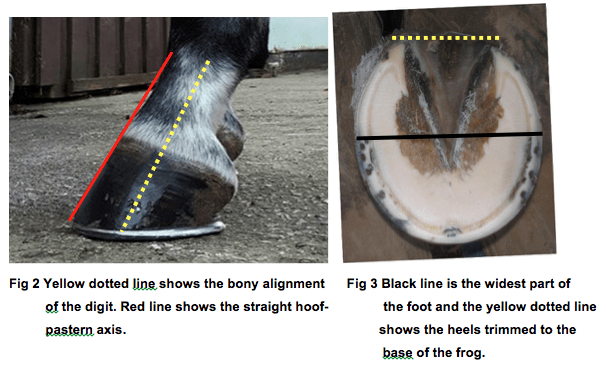
A closer look at these three guidelines, which are all interrelated, will help to show their importance. If the dorsal (front) surface of the pastern and the dorsal surface of the hoof are parallel or form a straight line, then the bones of the digit (P1, P2, P3) are in a straight line, and the force from the weight of the horse will go through the middle of the joint. Furthermore, and equally important, if the hoof-pastern axis is straight, the weight will be distributed evenly on the bottom of the foot.
2. Center of rotation (COR)
As the COR is located a few millimeters behind the widest part of each foot, it allows the farrier to apply appropriate biomechanics to each foot. The foot is trimmed in approximate proportions on either side of the widest part of the foot, which provides biomechanical efficiency.
3. The Heel

One should trim the palmar section of the foot to the base of the frog or trim such that the heels of the hoof capsule and the frog are on the same plane. Adherence to this guideline keeps the soft tissue structures (frog, digital cushion, ungula cartilages) within the hoof capsule, which are necessary to absorb concussion and dissipate the energy of impact. We must remember that heels do not grow tall, they grow forward. If we allow the heels to migrate forward, the soft tissue structures will be forced backward out of the hoof capsule. Furthermore, as the heels migrate forward, the weight is placed on the bone and lamellae, thus bypassing the soft tissue structures of the foot. Allowing the heels to migrate forward also decreases the ground surface of the foot.
These three guidelines can be applied to any foot and they serve as a basis for maintaining a healthy foot, as well as a basic starting point for applying farriery to a horse with poor foot conformation or one with a distorted hoof capsule.
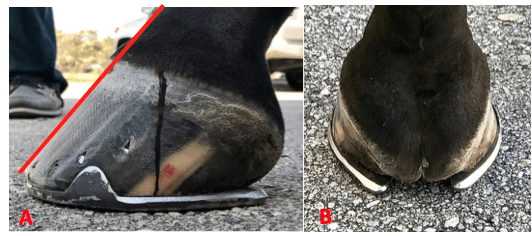
Palm Beach Equine Clinic is proud to have beneficial consulting relationships with many equine medical professionals throughout the country, including Dr. Stephen E. O’Grady, DVM, MRCVS, of Virginia Therapeutic Farriery. Dr. O’Grady provides advanced services in equine podiatry, offering comprehensive diagnosis, treatment, and maintenance for a variety of foot conditions using medical therapy as well as therapeutic shoeing.
Palm Beach Equine Clinic features the services of Dr. O’Grady for consultations year-round. With the experience and expertise of its world-class veterinarians, in addition to Dr. O’Grady’s wealth of knowledge, the Palm Beach Equine Clinic is able to provide the very best in advanced treatments in equine podiatry.
Equine Podiatry Services
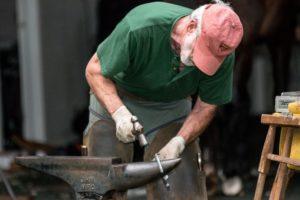
There is no structure on the horse that is as susceptible to injury, disease, or “wear and tear” than the equine foot. Proper, timely hoof care can often make the difference between a sound performance horse and one with chronic lameness. Some of the problems that Dr. O’Grady consults on include:
- Hoof Diseases
- Laminitis
- Severe Infections
- Advanced White Line Disease
- Therapeutic Horseshoeing
- Hoof Wall Defects
- Juvenile Orthopedics
Equine podiatry requires extensive knowledge of hoof anatomy, physiology, biomechanics and diagnostic imaging, as well as the farrier skills necessary to implement specialized shoeing. The combination of being educated as both a veterinarian and a professional farrier allows Dr. O’Grady to treat each foot problem with an understanding of the medical physiology and the mechanics involved. This blending of the two professions allows him to comprehensively diagnose, treat, and design a maintenance plan for a variety of foot conditions using medical therapy as well as therapeutic farriery. Dr. O’Grady also works together with referring veterinarians on difficult cases to discuss and assist with a plan that works for all parties.
Diagnostic Imaging for Equine Podiatry Cases
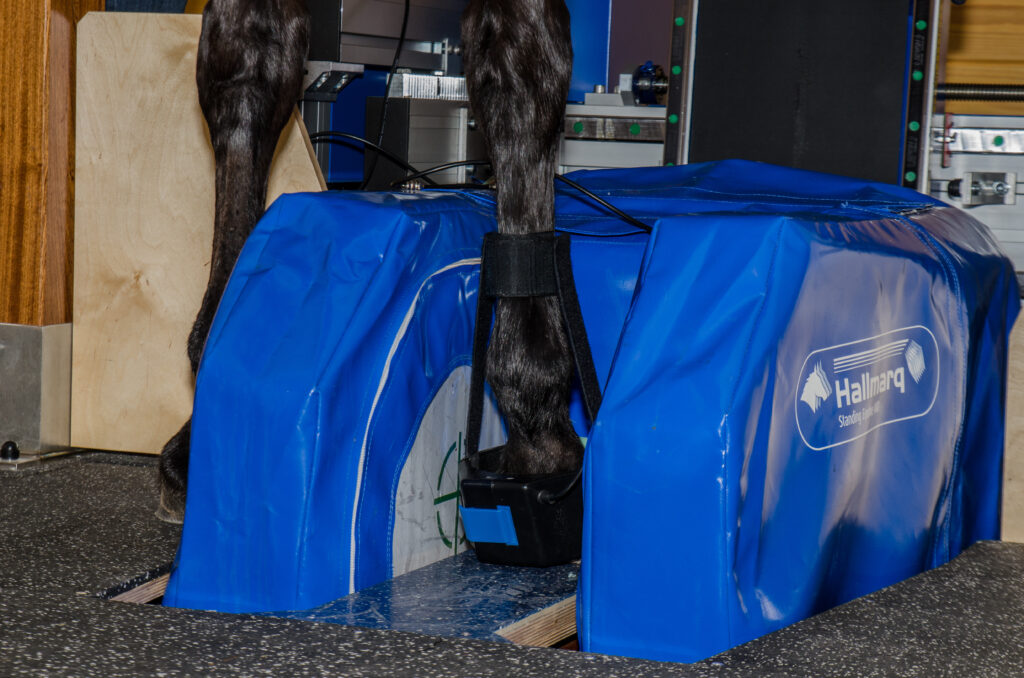
The advanced imaging equipment at Palm Beach Equine Clinic, in combination with Dr. O’Grady’s expertise, allow for comprehensive diagnosis and treatment of all hoof-related conditions. Palm Beach Equine Clinic offers a Hallmarq standing MRI that can provide a detailed diagnosis of any foot issues. Medical therapy, such as surgery and various medications, are often combined with therapeutic farriery for the best possible results. Dr. O’Grady’s methodology centers around using the basic principles of farriery, and when necessary, combining these principles with advanced technology and improved farrier products available on the market.
Equine podiatry consultations can be used for a variety of complicated hoof conditions where the problem is severe, chronic, and non-responsive to the present treatment. Hoof problems can include severe injuries, acute or chronic laminitis, hoof wall defects (non-healing quarter or toe cracks), hoof capsule distortions (club feet, long toe under-run heels), and severe hoof disease (infections, WLD, canker). There are many hoof-related problems that benefit from the advanced technology and farrier techniques available today.
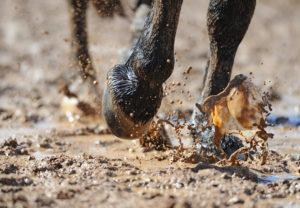
Thrush, rainrot, and scratches are problems that most equestrians have probably encountered, but in the hot, wet climate of South Florida, these issues can incessantly plague horses and their owners. While different in their presentation, thrush, rainrot, and scratches have a lot in common. For horse owners, there are several problems that arise due to environmental factors or predisposing conditions, but these issues can easily be prevented or treated with proper care and management.
This month, Palm Beach Equine Clinic’s Dr. Bryan Dubynsky shared his expertise on the causes, treatment, and prevention of thrush, rainrot, and scratches.
What is Equine Thrush?
Thrush is an infection within the horse’s hoof, most commonly caused by bacteria that invade the deeps clefts or grooves (known as sulci) of the frog. Fusobacterium Necrophorum is the common bacterial culprit, which naturally occurs in the environment, especially in wet, muddy, or unsanitary areas. Thrush bacteria thrives where there is a lack of oxygen.
Causes of Equine Thrush
Some horses are predisposed to developing thrush due to conformation, such as a rather high heel or deep sulci, or a narrow or contracted heel. The bacteria will manifest in horse’s feet that are not picked out regularly, or standing in muddy, wet environments, including paddocks or stalls that have not been cleaned properly.
Thrush can typically be first identified by the odor. The frog will have a strong, rotten odor and become spongy. Visually, the frog can even exudate (oozing) pus.
Treating Equine Thrush
The treatment for Thrush is fairly simple as it is very sensitive to oxygen. The most important thing is to have your vet or farrier trim or debride the frog to expose areas to the air. It is best to keep the hoof clean and dry. Adding a common detergent to the Thrush areas, such as Betadine or any commercial product (Thrush Buster, Coppertox, etc.) will help to kill the bacteria. Most importantly, if the horse is not removed from those predisposing environmental factors, treatments can be ineffective.
Maintaining a level of activity for our equine partners will increase blood flow to the feet and promote health to the area. Horses found in dry environments with ample space to move typically do not suffer from Thrush. The activity of horses moving keeps the frogs healthier. The more blood flow you have in the foot, the less chance that infection is able to manifest.
Thrush is not guaranteed to cause lameness. In extreme rare cases, Thrush can penetrate deeper and cause an infection in deeper tissue or even in the coffin bone. When in doubt, always contact your veterinarian.
What is Equine Rainrot (Dermotophilus Congolensis)?
Rainrot is caused by a naturally occurring bacteria named Dermotophilus, which produces spores. rainrot is recognized as scabby, scaly, crusty spots on areas of the horse that have been exposed to rain. It is commonly seen on the neck or across the back (dorsum). rainrot is not typically apparent on the legs or under the belly.
Causes of Rainrot

When there is a break in the skin, which can be even as simple as an insect bite, a surplus of rain on the skin washes away the natural protective oils. Once the skin is stripped of the natural protective layer or any sort of trauma to the skin barrier occurs, those spores are able to invade the deeper dermis skin layers. The spores penetrate into the deeper layers of the dermis, and the body reacts by sending white blood cells and proteins to fight the invaders. This reactive response causes the small pustules, scabs, and bumps to form.
Similar to thrush, rainrot is an environmental issue. It is most commonly seen in warm areas with high humidity, excess rain, and insects. The most important prevention is to keep horses out of the rain for prolonged periods of time. A horse can be out in the rain for short periods of a day or two, but if it is constantly in hot and rainy conditions with biting insects, more than likely the horse will develop rainrot.
Treating Equine Rainrot
Dr. Dubynsky emphasizes that topical products are not worth anything if the horse is not removed from the environmental factors. Once you remove the environmental factors, a keratolytic agent (something that exfoliates keratin), such as Benzoyl Peroxide or an antibacterial shampoo will help the skin heal. He also cautions that if the horse does have scabs, you do not necessarily want to pick the scabs off because then you are just leaving open skin without protection for more bacteria to invade. The most important tip to healing is to keep the area dry.
In very rare, severe cases of rainrot, it is best to contact your veterinarian to put the horse on antibiotics. If left untreated, and the horse is not removed from the environmental causative factors, the infestation can lead to Staphylococcal Folliculitis; a type of Staph bacteria that will invade the hair follicles and cause a more serious situation.
What are Equine Scratches?
Scratches is a generic term for many different ailments. The definition of scratches can be a bacterial, fungal, or viral dermatitis or inflammatory condition of the pastern or fetlock. It is defined as a chronic Seborrheic Dermatitis (flaking of the skin), characterized by hypertrophy (enlargement of tissue from an increase in cells) and exudation (escape of liquid from blood vessels through pores or breaks in the cell membranes) on the rear (palmar plantar) surface of the pastern and fetlock.
Causes of Equine Scratches
There are certainly predisposing factors for Scratches, including the same environmental factors that cause Thrush or Rainrot. Predisposing factors for Scratches include horses that are bathed often or stand in wet conditions all the time. Horses that have an excess amount of hair on their legs, especially draft horses, also develop scratches easily because the hair traps dirt and moisture on the skin.
Scratches can develop in horses that are bathed too often such as the intensely managed show horse. The show horse is desired to be very clean, which can mean several baths a day. This will strip away the natural protective oils and barrier of the dermis, which allows bacteria or fungi to invade. When moisture penetrates the skin, it causes inflammation reacting with heat, redness, pain, and loss of protection to keep bacteria out.
Prevention and Treatment of Equine Scratches
The most effective first step for prevention and treatment should be to remove the environmental predisposing factors. Removing excess hair during the humid months and keeping horses clean and dry to the best of your ability will reduce the probability of developing an infection. Bathing horses once a day with Betadine or antifungal/antibacterial shampoo will help to clear the infection. Be sure to leave the shampoo on for 20 minutes for all of the medicine to penetrate, rinse thoroughly, and make sure the horse is completely dry. In order to effectively treat the bacteria, horses should be completely towel or air dried before returning to their stalls or paddocks.
As always, contact your veterinarian immediately if there appears to be deeper infection present, or you would like more detailed information on how to treat and prevent these bacterial infections. For more information, contact Palm Beach Equine Clinic at 561-793-1599.
Equine Ophthalmology
Article by Susan M. Carastro, DVM, MS
Diplomate, American College of Veterinary Ophthalmologists
Palm Beach Equine Clinic is proud to have great consulting relationships with many equine medical professionals throughout the country, including Susan M. Carastro, DVM, MS, of the Animal Eye Specialty Clinic. A Diplomate of the American College of Veterinary Ophthalmologists, Dr. Carastro shared her expertise on some of the most common diseases of the equine eye.
Understanding the Equine Eye
Equines have a uniquely developed eye suited to accommodate the lifestyle and needs of our equine companions. The location of the equine eyes being on the side of the head allows for a more panoramic view for protection. This is imperative to the fight or flight response as visual detection of a threat is necessary to alert the flight animals to flee.
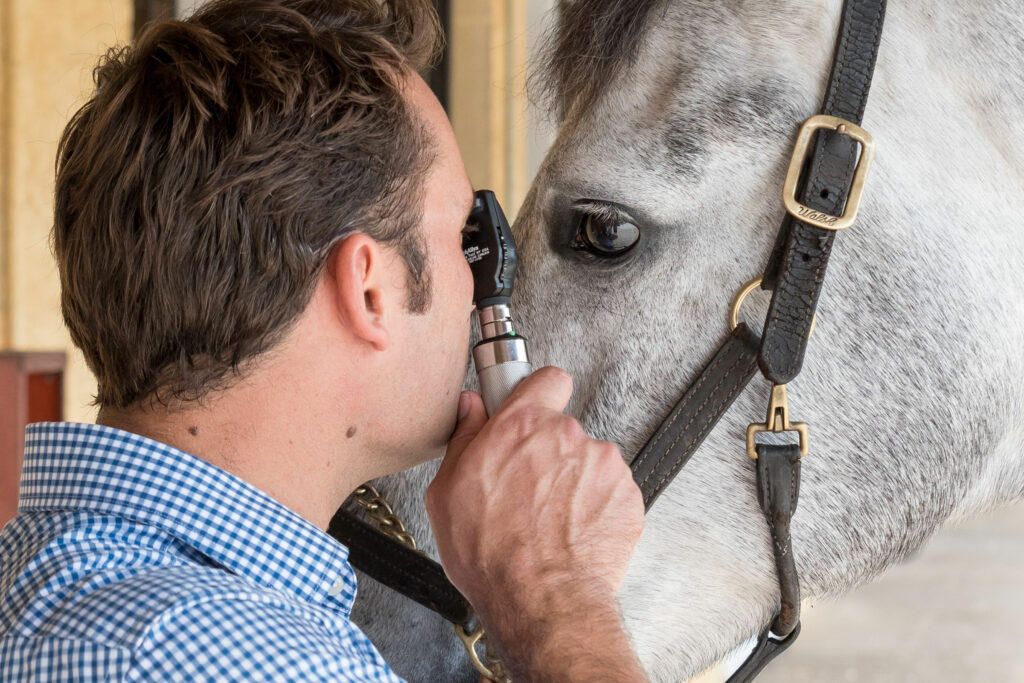
Protecting the Horse’s Eyes
There are a few common diseases of the equine eye that are worth having basic knowledge about. Early recognition and proper treatment is ideal to minimizing damage to the eye. Eyelid cuts or lacerations can occur with contact of numerous objects, but most commonly occur with catching the eyelid on a metal S ring on buckets or nails, or splits in the lid margin from blunt trauma. Eyelid lacerations are easily identified and repaired with primary closure or suturing.
The eyelids have an extensive blood supply and can bleed excessively. As long as the globe is not damaged, the eyelids have an excellent capacity to heal with minimal impact on ocular health. No matter how extensive the laceration appears, every attempt should be made to salvage as much eyelid margin as possible. Allowing the eyelids to heal without suturing can result in poor cosmetic appearance, enhanced scarring, and irregular eyelid margins. The scarring can result in hair or lashes contacting the cornea surface causing chronic irritation or discomfort.
Corneal injuries are one of the most common vision-threatening and painful equine eye diseases. The cornea is the front clear part of the eye that protects the delicate intraocular structures. Ulcers are generally due to abrasion or puncture with environmental objects (hay, branches, and sand). Clinical signs of a corneal ulcer include squinting, tearing, swelling around the eye, redness to the eye, and/or cloudiness to the eye. Corneal ulcers can be confirmed by careful examination of the equine eye and staining with a green dye (fluorescein). Uncomplicated superficial corneal ulcers can heal without leaving any residual damage. Once an ulcer has occurred, the main concern is the risk of corneal infection. Topical therapy with antibiotics, as well as anti-fungal agents four times daily is recommended until the ulcer heals.
Equine Eye Infections and Conditions
Bacterial and/or fungal corneal infections can be devastating and result in loss of vision and the eye. These infections are more common in the southeastern United States with the heat and humidity supporting the growth of these organisms. If a corneal infection occurs, aggressive topical therapy up to every hour and in many cases, surgery, is necessary to save the eye.
Hourly medication can be quite difficult due to personal time constraints, and the horse will keep the eye forcefully closed because of the pain and light sensitivity. A subpalpebral lavage system can be placed for easier and more effective treatment. This is a small tube or catheter inserted through the upper or lower eyelid with the injection port being attached to the mane near the withers. The lavage allows for medication to be injected through the catheter to reach the eye without coming near the horse’s head. Corneal infections in horses can take months to clear. Corneal ulcers can also be extremely painful, thus pain control with atropine and banamine will minimize discomfort and distress.
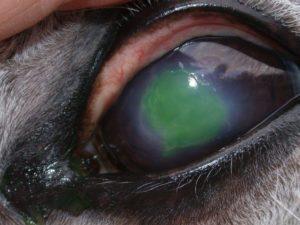
Equine recurrent uveitis or moon blindness affects horses worldwide. Uveitis is an inflammation of the iris (colored part of the eye) that can be caused by numerous issues. These include trauma, infections in other parts of the body, or can be generated by the horse’s own immune system, but there is also a genetic predisposition for Appaloosas and Draft breeds.
Signs and Treatment of Equine Recurrent Uveitis
Clinical symptoms of uveitis include a painful eye (squinting, tearing), cloudiness to the eye, and swelling around the eye. If uveitis is diagnosed, evaluation for infections or inflammations elsewhere in the body should be pursued. This may include bloodwork, titers for specific infections including Leptospirosis, abdominal ultrasound, chest radiographs, and sampling of fluid from inside the equine eye.
If no underlying cause can be identified, the main goal is minimizing inflammation inside of the eye to control pain and limit the impact on vision.
Treatments that are used include topical steroids and nonsteroidal agents, oral steroids and nonsteroidal agents (banamine/bute), and atropine.
Management
The frustrating part of this disease is the recurrent nature. The interval of flare-ups can range between days to years in patients. Management for horses affected with uveitis is to limit the frequency and severity of the episodes with lifelong treatment. This can be accomplished with daily maintenance medication (topical and/or oral) even when there is no active inflammation. If the equine eye is still having flare-ups, surgical implantation of a device impregnated with anti-inflammatory medication called cyclosporine allows for a constant release of drug into the eye to limit episodes.
If the uveitis remains poorly controlled, further consequences including cataracts, glaucoma, and retinal detachment can result in loss of vision and a painful eye requiring removal of the eye.
Equine eye diseases can generally be managed with early recognition, assistance from your veterinarian in establishing a diagnosis, and effective treatment. Please contact your veterinarian if you notice any of the above symptoms as soon as possible, as it may save your horse’s eyesight. Any of Palm Beach Equine Clinic’s veterinarians are available to answer any questions.

In the summer months, it is extremely important to be aware of how the heat and sun can affect our horses. As the summer heats up around the country and especially in Florida, Palm Beach Equine Clinic would like to remind all equine owners to keep their horses in a cool, well-ventilated environment with protection from the hot weather.
There are many problems that can arise in the summer months from overheating, to dehydration, and even equine sunburn that owners should always keep in mind.
Covered Areas to Protect Your Horse
All horses should have access to shade and cool water throughout the day. Any exercise should be scheduled when the temperatures are lower, usually earlier or later in the day. Turnout should be limited to the night or cooler portions of the day, and fans can be provided indoors during extreme heat.
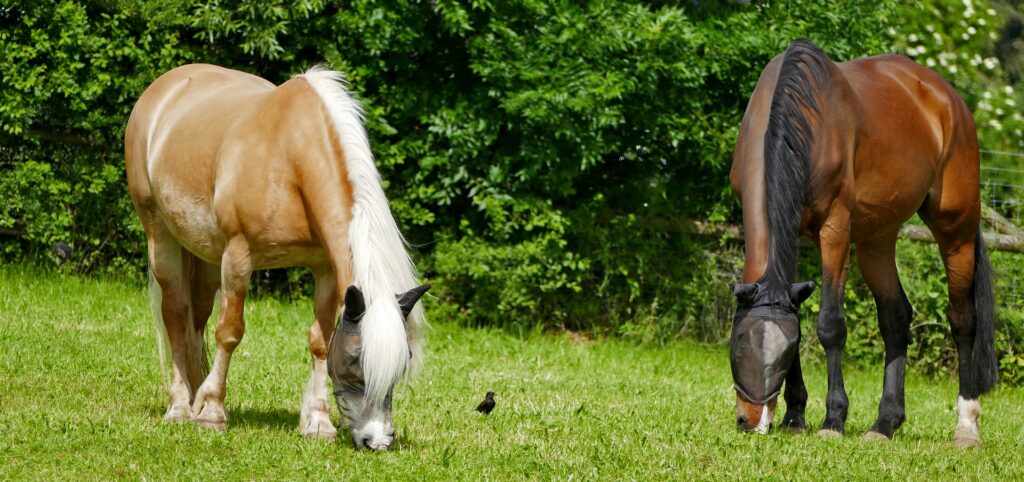
The average horse drinks between 5 to 10 gallons of water per day. It is important to provide clean, fresh water at all times and be aware of increased water necessities during extremely hot days.
Sweat and Sodium Levels
Sodium in your horse’s diet is very important to maintaining proper hydration. Providing a salt block or supplementing with electrolytes can help ensure that your horse is meeting their sodium requirements.
Especially in the extreme summer heat, horse owners should pay attention to the amount of sweat their horse is producing. Anhidrosis, or the inability to sweat normally, can be a common challenge for our equine partners in the summer months, particularly in hot, humid climates. In addition to lack of sweat, signs of Anhidrosis can include increased respiratory rate, elevated temperature, areas of hair loss, or dry, flaky skin. If you notice any of these signs, contact your veterinarian immediately.
Equine Sunburn Tips
Horses with white on their faces or bodies are especially prone to sunburn and should be protected from the harsh UV rays of the sun. Providing shade, covering your horse’s skin with fly sheets or fly masks, and applying sunscreen are all helpful ways to prevent a burn.
Fly masks are now made with extensions to cover the nose and muzzle. There are many different sunscreen products made specifically for horses, but most products approved for human use are also safe for our equine partners. Once again, horses that are particularly prone to sunburn can be kept cool and safe from the sun by staying indoors during the day and being turned out at night.
These are just a few of the important issues to be aware of during the hottest time of the year in Florida and around the country. Remember to keep your horse cool, well-hydrated, and protected from the heat and sun. Contact the veterinarians at Palm Beach Equine Clinic to learn more about precautions that can be taken to keep your horse happy and healthy throughout the summer months.

